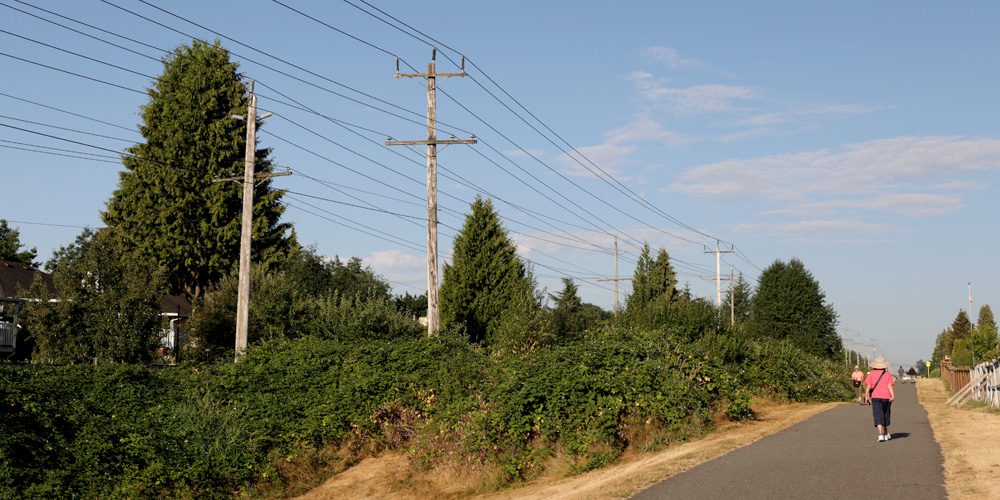Home » Greening the grid: How to keep electricity sustainable — and affordable
Greening the grid: How to keep electricity sustainable — and affordable

The transition to clean energy will cost billions. Startups and corporations are working to ensure electricity remains cost effective.
At the southern edge of Parry Sound, Ont., 10 neat rows of solar panels stand where a landfill used to be. The solar farm is part of the town’s push to become a net-zero community. That effort also includes building a 2.5-megawatt battery, installing Tesla Powerwall storage systems in 10 buildings, adding electric vehicle chargers, and equipping 50 homes and businesses with smart thermostats on their water heaters.
The project, known as Speedier, is showing how new technologies can work together to balance supply and demand on a grid that uses renewable energy. But it has an additional benefit: it results in fewer outages for some residents. According to Vince Kulchycki, chief operating officer at utility company Lakeland Power, which led the project, rural communities are prone to power cuts from incidents like falling tree branches. Speedier has created a microgrid that can operate in isolation from the wider electricity network if need be. “We’ve had some outages where the power’s completely out and this grid stays on. It’s seamless, there’s no off and then on again,” says Kulchycki.
Speedier is an example of the clean and flexible electricity system that Canada will need to meet its climate goals. But orchestrating the shift to a greener grid will be difficult and expensive. With demand for electricity expected to increase 50 per cent in the next decade, RBC has warned that Ontario could face power shortages as soon as 2026. The bank projects that up to $7 billion must be spent on energy storage systems alone to plug gaps in supply when conditions aren’t suitable for wind or solar generation.
With governments around the world focused on cutting emissions quickly, some industry watchers argue that more support will be needed for low-income individuals and communities that are least able to adjust to higher costs or protect themselves from outages by investing in technologies like at-home energy storage.
“The energy transition is going to run right into the energy poverty issue, because oftentimes renewable energy is going to be more expensive than the way we’ve been producing electricity right now,” says Daniel Larsen, co-founder Stash Energy, which manufactures energy-storing heat pumps. “I feel for people who are renting or living on a fixed income. They can’t install solar on their roof. They can’t necessarily purchase more efficient appliances. It’s a huge issue and it’s something that we’re going to have to confront as a society. This energy transition can’t come at the expense of people who can’t afford it.”
Parry Sound’s project received funding from the federal government rather than bill payers, and Kulchycki stresses that utility companies are keenly aware of the need to keep energy affordable, especially for lower-income groups. But it seems inevitable that governments will have to provide more support for communities as they transition to clean power and create new programs that help people buy energy-saving devices.

Learn more about how to rethink our power systems
on the new MaRS podcast Solve for X
Destenie Nock, an assistant professor of engineering and public policy at Carnegie Mellon University, says there is already an “energy equity gap” in the U.S. as people with lower incomes cut back their energy use. Research has shown that during hot weather, lower income groups wait until the temperature rises between four and seven degrees Fahrenheit higher before they turn on their air conditioning compared to wealthier people.
As dangerous heatwaves become more common across the U.S., numerous heat-related deaths have been linked to individuals rationing their air conditioning use in hard-hit states like Arizona.
Nock says that governments should focus on the communities that will be hardest to convert to clean energy and come up with workable plans for these. That might include looking beyond wind and solar to things like tidal or geothermal power if those make more sense in some places.
“There’s a ton of communities out there that can adopt wind and solar and benefit from it,” says Nock. “But there are a lot of other renewables that we should be looking into developing further.”
The goal, says Nock, should be to create a sustainable and equitable power system. “It’s about making sure that people feel like they can consume what they need to in order to have a comfortable, healthy and safe life.”
Adopting breakthrough tech solutions means staying ahead of the competition. Become a MaRS Corporate Innovation member and gain exclusive access to our ecosystem.
MaRS Discovery District
https://www.marsdd.com/
MaRS is the world's largest urban innovation hub in Toronto that supports startups in the health, cleantech, fintech, and enterprise sectors. When MaRS opened in 2005 this concept of urban innovation was an untested theory. Today, it’s reshaping cities around the world. MaRS has been at the forefront of a wave of change that extends from Melbourne to Amsterdam and runs through San Francisco, London, Medellín, Los Angeles, Paris and New York. These global cities are now striving to create what we have in Toronto: a dense innovation district that co-locates universities, startups, corporates and investors. In this increasingly competitive landscape, scale matters more than ever – the best talent is attracted to the brightest innovation hotspots.


